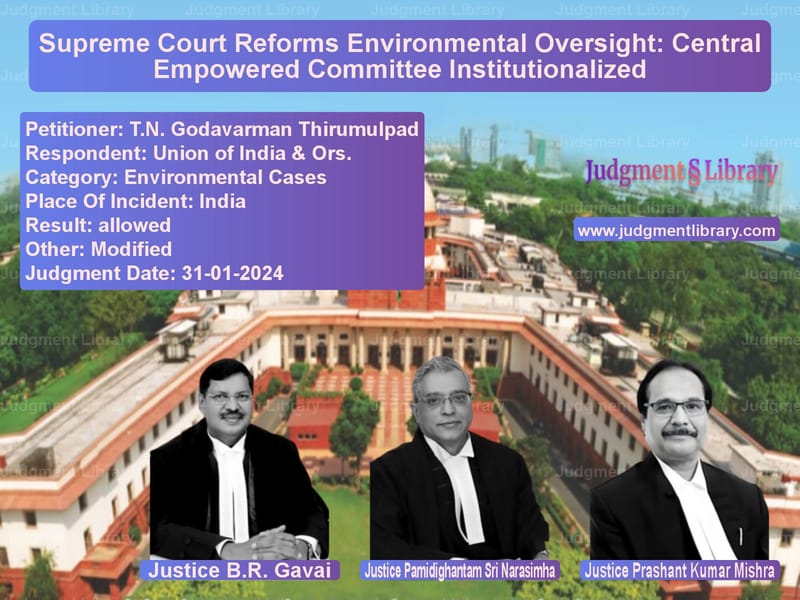Supreme Court Reforms Environmental Oversight: Central Empowered Committee Institutionalized
The Supreme Court of India, in a landmark judgment, institutionalized the Central Empowered Committee (CEC) as a permanent statutory body for environmental governance in the case of In Re: T.N. Godavarman Thirumulpad vs. Union of India & Ors. The ruling emphasized the need for a structured, accountable, and transparent mechanism to oversee the implementation of environmental laws and ensure compliance with judicial directives.
Background of the Case
The case originated in 1995 when environmentalist T.N. Godavarman Thirumulpad filed a writ petition before the Supreme Court seeking the protection of India’s forests. Over the decades, this case became the foundation for numerous environmental regulations and oversight mechanisms. In 2002, the Supreme Court had constituted the CEC as an ad hoc body to monitor compliance with its orders on forest and wildlife conservation.
Issues Before the Supreme Court
- Whether the Central Empowered Committee (CEC) should be institutionalized as a permanent body?
- What should be the structure, powers, and responsibilities of the CEC?
- How can the functioning of the CEC be improved to enhance environmental governance?
Petitioner’s Arguments
The petitioner argued:
- The CEC had played a crucial role in monitoring environmental compliance, but its ad hoc nature limited its effectiveness.
- There was a need for a structured, transparent, and accountable statutory body to oversee environmental governance.
- The lack of a permanent institutional framework had led to delays and inconsistencies in the enforcement of environmental laws.
Respondent’s Arguments
The Union of India, represented by the Solicitor General, submitted:
- The government was willing to institutionalize the CEC as a statutory body under the Environment (Protection) Act, 1986.
- The proposed framework would define the qualifications, tenure, and responsibilities of the CEC members.
- The institutionalization of the CEC would improve environmental oversight and policy implementation.
Key Observations by the Supreme Court
The Supreme Court, after reviewing the submissions, made the following observations:
“For effective functioning of the CEC, it is appropriate that some of the old members, who have attained an advanced age or are not available in India all the time, are replaced by younger members.”
“Environmental rule of law means governance that is underpinned by the fundamental tenets of transparency, accountability, and inclusiveness.”
“The CEC shall be a permanent body with clear guidelines for decision-making, public participation, and accountability in environmental matters.”
Final Judgment
The Supreme Court issued the following directives:
- The CEC shall be institutionalized as a permanent statutory body under the Environment (Protection) Act, 1986.
- The Central Government shall issue a notification specifying the composition, tenure, and responsibilities of the CEC.
- The CEC shall consist of a Chairman, a Member Secretary, and three expert members (from the fields of environment, forest, and wildlife).
- The CEC shall have the power to monitor environmental compliance, advise the government, and conduct independent investigations.
- The CEC shall operate under the administrative control of the Ministry of Environment, Forest, and Climate Change (MoEFCC) but will have functional autonomy.
- The government must ensure adequate funding and resources for the CEC to perform its functions effectively.
Implications of the Judgment
The Supreme Court’s ruling has far-reaching implications for environmental governance in India:
- Enhanced Oversight: The CEC will serve as a dedicated watchdog to ensure compliance with environmental laws and Supreme Court orders.
- Transparency and Accountability: The decision mandates periodic audits, public disclosure of decisions, and stakeholder participation.
- Expertise-Driven Decision Making: The inclusion of experts ensures that environmental policies are guided by scientific knowledge and best practices.
- Institutional Stability: The ruling ends the ad hoc functioning of the CEC, providing a structured mechanism for long-term environmental governance.
Conclusion
The Supreme Court’s decision in T.N. Godavarman Thirumulpad vs. Union of India marks a significant step toward strengthening India’s environmental regulatory framework. By institutionalizing the Central Empowered Committee as a permanent statutory body, the judgment ensures better enforcement of environmental laws, improved transparency, and a more effective approach to protecting India’s forests and wildlife.
Petitioner Name: T.N. Godavarman Thirumulpad.Respondent Name: Union of India & Ors..Judgment By: Justice B.R. Gavai, Justice Pamidighantam Sri Narasimha, Justice Prashant Kumar Mishra.Place Of Incident: India.Judgment Date: 31-01-2024.
Don’t miss out on the full details! Download the complete judgment in PDF format below and gain valuable insights instantly!
Download Judgment: t.n.-godavarman-thir-vs-union-of-india-&-ors-supreme-court-of-india-judgment-dated-31-01-2024.pdf
Directly Download Judgment: Directly download this Judgment
See all petitions in Environmental Cases
See all petitions in Public Interest Litigation
See all petitions in Judgment by B R Gavai
See all petitions in Judgment by P.S. Narasimha
See all petitions in Judgment by Prashant Kumar Mishra
See all petitions in allowed
See all petitions in Modified
See all petitions in supreme court of India judgments January 2024
See all petitions in 2024 judgments
See all posts in Environmental Cases Category
See all allowed petitions in Environmental Cases Category
See all Dismissed petitions in Environmental Cases Category
See all partially allowed petitions in Environmental Cases Category







